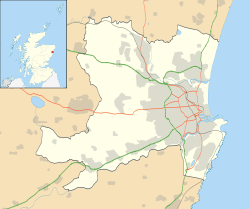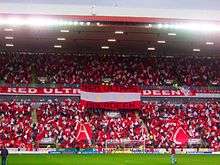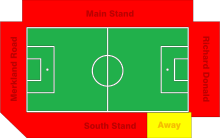Pittodrie Stadium
|
View from Broad Hill towards the stadium | |
 Pittodrie Stadium Location in Aberdeen | |
| Location | Aberdeen, Scotland |
|---|---|
| Coordinates | 57°09′33″N 2°05′20″W / 57.15917°N 2.08889°W |
| Owner | Aberdeen F.C. |
| Capacity | 20,866 (Football)[1] |
| Field size | 109 yd × 72 yd (100 m × 66 m) |
| Surface | Grass |
| Construction | |
| Broke ground | 1899 |
| Opened | 2 September 1899[2] |
| Renovated | 1993 (Richard Donald Stand opened) |
| Construction cost | GB£4.5 million (Richard Donald stand) |
| Tenants | |
|
Aberdeen (2 September 1899 – 18 April 1903) Aberdeen FC (18 April 1903 - present) Inverness Caledonian Thistle FC (7 August 2004 – 28 January 2005) | |
The Pittodrie Stadium is an all-seated football stadium situated in the Scottish city of Aberdeen. It was first used in 1899 and from 1903 has been the home of Aberdeen Football Club. Since then, it has been the location of a number of firsts in the field of stadium design, notably becoming one of the first all-seater stadia in the United Kingdom.[3]
It is now one of the largest football stadia in Scotland and has a seating capacity of 20,866;[1] only Celtic Park, Murrayfield, Hampden and Ibrox are larger. This makes Pittodrie the largest stadium in Scotland outside of the Central Belt. In addition to its main duty of hosting home matches for Aberdeen FC, it has been the venue for a number of Scottish international matches and occasional games of rugby union.
History
Pittodrie’s original tenants were the original Aberdeen club, a precursor to Aberdeen FC, which along with other local clubs Victoria United and Orion amalgamated on 18 April 1903. Having previously played their football at various venues within the city, a former dung hill for police horses was chosen by Aberdeen to be cleared and readied for football on 1 February 1899. The land was leased from Mr Knight Erskine of Pittodrie with an agreement to construct a terrace on what is now the site of the Richard Donald Stand. On 2 September 1899, the first game was played in the new home, known then as Pittodrie Park; a 7–1 win over Dumbarton. On 15 August 1903, 8000 spectators turned up to watch the new Aberdeen FC draw 1–1 against Stenhousemuir, the first game played at Pittodrie by its amalgamated tenants.
Increasing popularity of the team and rising attendances lead to continued construction on Pittodrie, and a number of football firsts throughout the years. Aberdeen FC purchased the ground they had been leasing, with the final payment made on 1 December 1920. In 1925 the Main Stand, where the club offices, dressing rooms and trophy room are located, was constructed. Also in the 1920s, the dugout was introduced to football by coach Donald Coleman, who was interested in sitting lower to the pitch in order to inspect the players' footwork.[4]

After the Second World War, the team won its first trophy, a Scottish Cup victory, and with increased success came more additions to Pittodrie. The record attendance occurred on 13 March 1954, when 45,061 spectators turned up for a Scottish Cup match between Aberdeen and Heart of Midlothian. Floodlights were introduced at Pittodrie on 21 October 1959, when English league side Luton Town were beaten 3–2 in a friendly. By the 1 August 1968, the Main Stand had become all-seated as part of a £100,000 improvement of the ground. This coincided with a change of name from Pittodrie Park to Pittodrie Stadium. On 6 February 1971, a fire destroyed part of the Main Stand, and gutted the dressing rooms and club offices. The Scottish Cup – held by Aberdeen at the time – had to be rescued by firemen.
In 1978, Pittodrie became the second all-seated stadium in Great Britain, after the south terracing was fitted with bench style seating.[5] (Clydebank had done something similar two years before as a response to being promoted to the Premier Division). This improvement pre-dated the Taylor Report on British football grounds by a decade and coincided with a distinct upturn in the fortunes of the home team, now managed by Alex Ferguson. The south side became the South Stand in 1980, following the installation of a cantilever roof which covered most of the seats.[5] A year later, the benches were replaced by individual seats.[5]
Both during the subsequent run in the 1980s and at numerous other times over the century the stadium has been in operation, there have been many memorable nights for the local fans. However, Pittodrie’s greatest night is generally regarded as 16 March 1983. Aberdeen fought back from 2–1 down in a European Cup Winners' Cup quarter-final second leg tie against top German team FC Bayern Munich to win 3–2. A full house witnessed this victory take the Dons through to the semi-finals; they went on to win the trophy. The club installed 24 executive boxes in the Main Stand, and built a new roof over the Merkland Road End in 1985.[6] Undersoil heating was installed in 1987.[6]

The most recent development of the stadium came in the 1992-93 season when the Beach End stand on the east side of the ground was demolished, with the new Richard Donald stand - named after the club's long serving chairman - constructed in its place. On 1 August 1993, the new stand was opened with a League Cup tie against Clydebank. The official opening was carried out later in 1993 by Princess Anne. It is currently the only two tier stand in the stadium. The stadium has remained relatively unchanged since then, although some minor improvements, such as the introduction of an electronic stadium entry system for the 2006–07 season, have been carried out.
The site of the stadium is only 500 metres away from the North Sea, and with only the King's Links golf course between the stadium and the beach, the ground is one of the coldest football grounds in Britain.
As a result of a ground sharing agreement, Pittodrie was used by Inverness Caledonian Thistle for their home matches during the early part of the 2004–05 season. This was required because Inverness CT's own Caledonian Stadium did not meet the requirements for entry into the Scottish Premier League until improvements were carried out and the seating capacity increased. In 2005 the stadium size criterion for entry to the SPL was reduced to 6,000, thereby allowing Inverness Caledonian Thistle to return to their home stadium partway during the season.

Structure and facilities


The Main Stand was the original grandstand within the ground, and contains much of the staff and offices responsible for the day-to-day running of the stadium, from the boot room to the trophy room. Teams enter the pitch from a tunnel to the extreme left of this stand. As befits a main stand, this section of the ground includes both padded seating for club officials and VIPs, and several executive boxes at the rear. There are a number of pillars running along this stand, supporting the roof. As a consequence, views in some places are restricted. It remains, however, the most expensive stand from which to watch matches. To the east of the Main Stand is the club shop, which doubles as a ticket office.
The Richard Donald Stand is named after former club chairman Dick Donald. Completed in 1993, it houses over 6,000 fans, although this is a reduction on its Beach End predecessor. It is a cantilever construction with two tiers and a row of twelve executive boxes in between. It is commonly referred to as simply the "RDS". It was built by the present chairman’s construction firm, the Stewart Milne Group, at a cost of £4.5 million. Within this stand are a number of banqueting rooms, which are used for corporate hospitality and outside bookings.
Taking its name from the street behind it, the Merkland Stand (also known as 'the Paddock' or 'King Street End') sits behind the goal, on the west of the ground. The Merkland is Aberdeen FC’s family stand, with reduced prices for under-twelves and families. There is also a section for disabled supporters near the pitch. The stand itself is a covered enclosure, with two pillars supporting the roof. The entrance to the stand is dominated by a façade constructed from granite, a local stone.
Named simply after its position within the ground, the South Stand was originally an undeveloped embankment which was later remodelled as a standing terrace. Seating and a cantilever roof were later added, although some of the 8,400 seats remain uncovered. Since 1993, the easternmost part of the stand has been used to house away fans. Sections P, Q and R are designated for this purpose. The television gantry and commentary positions are housed in this stand.
Future developments
Despite improvements and its ground-breaking past, it appears that the future of Pittodrie as a football stadium is uncertain. Plans are in action for the club to move to a New Aberdeen Stadium. The principle of a move, rather than a redevelopment of Pittodrie, has already been recommended by Aberdeen City Council. An earlier plan to move to the edge of the city, which corresponded with Scotland’s failed joint bid for the Euro 2008 tournament, has been scrapped.
In June 2006, the club's two major shareholders agreed a plan to sell the land on which the stadium sits to clear some of the club’s debt.[7]
Other uses
Since its construction, there have been thirteen Scotland international matches staged at Pittodrie. Normally these matches are played at Hampden Park in Glasgow, but during times of redevelopment of the national stadium, or matches which are expected to draw a low crowd, the Scottish Football Association has made use of other stadia in the country. Playing at Pittodrie, Scotland have won nine matches, drawn two and lost two.
| 3 February 1900 | Scotland |
5 – 2 | |
1900 British Home Championship |
|---|---|---|---|---|
| Bell D. Wilson Hamilton Smith |
T.D. Parry W.T. Butler |
Attendance: 12,500 Referee: C.E. Sutcliffe (England) |
| 12 February 1921 | Scotland |
2 – 1 | |
1921 British Home Championship |
|---|---|---|---|---|
| Wilson |
D.J. Collier |
Attendance: 20,824 Referee: J. Mason (England) |
| 21 November 1935 | Scotland |
3 – 2 | |
1936 British Home Championship |
|---|---|---|---|---|
| Duncan C.E. Napier |
C. Phillips D.J. Astley |
Attendance: 26,334 Referee: S. Thompson (Northern Ireland) |
| 10 November 1937 | Scotland |
1 – 1 | |
1938 British Home Championship |
|---|---|---|---|---|
| Smith |
P. Doherty |
Attendance: 21,878 Referee: A.J. Jewell (England) |
| 10 November 1971 | Scotland |
1 – 0 | |
1972 European Championship qualifier |
|---|---|---|---|---|
| O'Hare |
Attendance: 36,500 Referee: Bostrom (Sweden) |
| 16 May 1990 | Scotland |
1 – 3 | |
Friendly match |
|---|---|---|---|---|
| McCoist |
Youssef Hassan Hamid |
Attendance: 23,000 Referee: Pedersen (Norway) |
| 2 June 1993 | Scotland |
3 – 1 | |
1994 World Cup qualifier |
|---|---|---|---|---|
| McClair Nevin |
Bragin |
Attendance: 14,307 Referee: Ouzounov (Bulgaria) |
| 8 September 1993 | Scotland |
1 – 1 | |
1994 World Cup qualifier |
|---|---|---|---|---|
| Collins |
Bregy |
Attendance: 15,000 Referee: Quiniou (France) |
| 7 September 1997 | Scotland |
4 – 1 | |
1998 World Cup qualifier |
|---|---|---|---|---|
| Gallacher Hopkin |
Katchouro |
Attendance: 20,160 Referee: van der Ende (Netherlands) |
| 14 October 1998 | Scotland |
2 – 1 | |
2000 European Championship qualifier |
|---|---|---|---|---|
| Dodds Burley |
Petersen |
Attendance: 18,517 Referee: Kapitanis (Cyprus) |
| 17 April 2002 | Scotland |
1 – 2 | |
Friendly match |
|---|---|---|---|---|
| 17:45 | Dailly |
Report | Aghahowa |
Attendance: 20,465 Referee: Øvrebø (Norway) |
| 22 August 2007 | Scotland |
1 – 0 | |
Friendly match |
|---|---|---|---|---|
| 20:00 | Boyd |
Report | Attendance: 13,723 Referee: Atkinson (England) |
| 16 November 2010 | Scotland |
3 – 0 | |
Friendly match |
|---|---|---|---|---|
| 20:00 | Wilson Commons Mackie |
Report | Attendance: 15,064 Referee: van Boekel (Netherlands) |
| 6 February 2013[8] | Scotland |
1 – 0 | |
Friendly match |
|---|---|---|---|---|
| 19:45 | Mulgrew |
Report | Attendance: 16,102 Referee: Clement Turpin (France) |

Rugby union
Since 2005, Pittodrie has hosted four rugby union internationals.
| Date | Country | Score | Country | Victor |
|---|---|---|---|---|
| 24 May 2005 | |
38 – 9 | Barbarians | |
| 22 November 2008 | |
41 – 0 | |
|
| 27 November 2010 | |
19 – 16 | |
|
| 24 November 2012 | |
15 – 21 | |
|
Concerts
Pittodrie has been used for concerts; both Elton John[9] and Rod Stewart[10] have played at Pittodrie.
References
- 1 2 "Aberdeen Football Club". Scottish Professional Football League. Retrieved 30 September 2013.
- ↑ "Pittodrie Stadium".
- ↑ "Profile". Aberdeen Football Club. Retrieved 18 June 2011.
- ↑ Bauckham, David (2003). Dugouts. New Holland Publishers (UK) Ltd. ISBN 1-84537-478-9.
- 1 2 3 Inglis 1996, p. 424
- 1 2 Inglis 1996, p. 425
- ↑ "BBC SPORT | Football | My Club | Aberdeen | Dons rescue package eyes new home". BBC News. 13 June 2006. Retrieved 22 March 2009.
- ↑ "Scotland set up Estonia friendly in Aberdeen". BBC Sport. BBC. 17 August 2012. Retrieved 19 August 2012.
- ↑ "26,000 pack Pittodrie as Elton John's world tour rolls into Aberdeen's sell-out gig". The Scotsman. 19 June 2004. Retrieved 18 June 2011.
- ↑ "Rod Stewart wows fans at Aberdeen concert". Evening Express. 6 June 2011. Retrieved 18 June 2011.
- Sources
- Inglis, Simon (1996). Football Grounds of Britain. Collins Willow. ISBN 0-00-218426-5.
External links
| Wikimedia Commons has media related to Pittodrie Stadium. |
Coordinates: 57°09′33″N 2°05′20″W / 57.15917°N 2.08889°W
